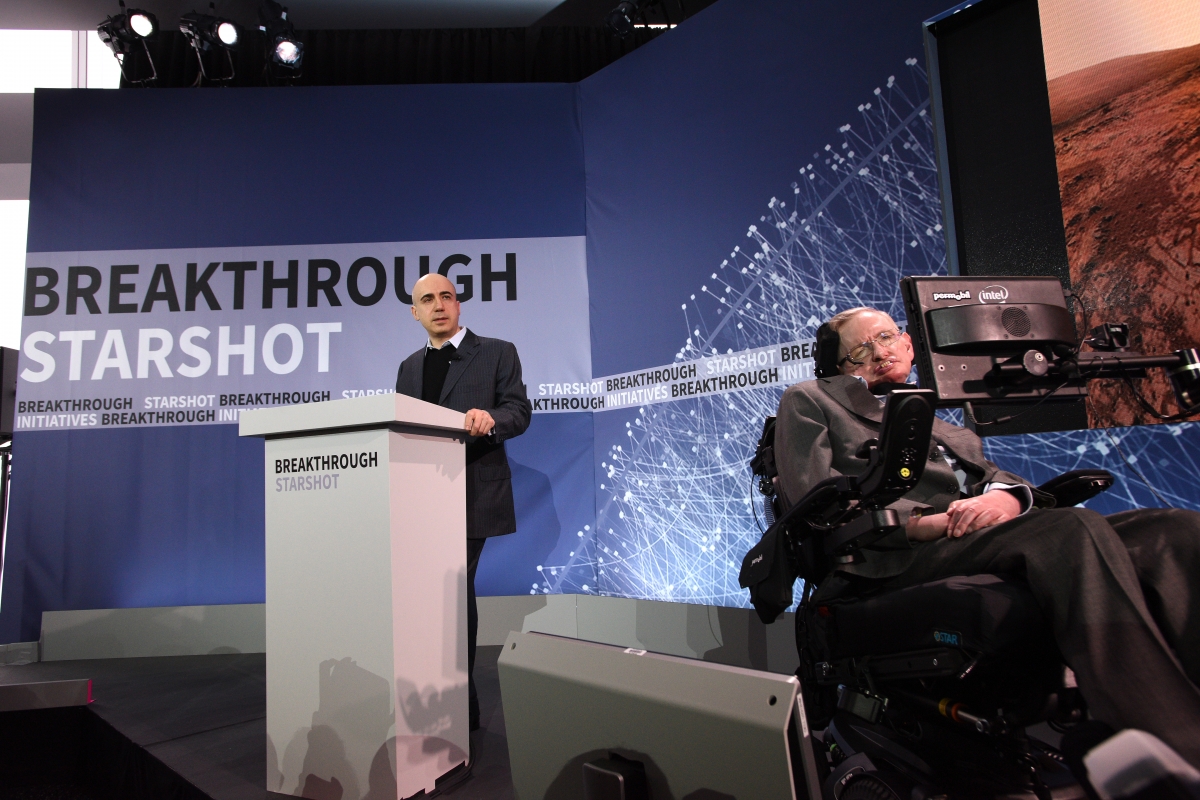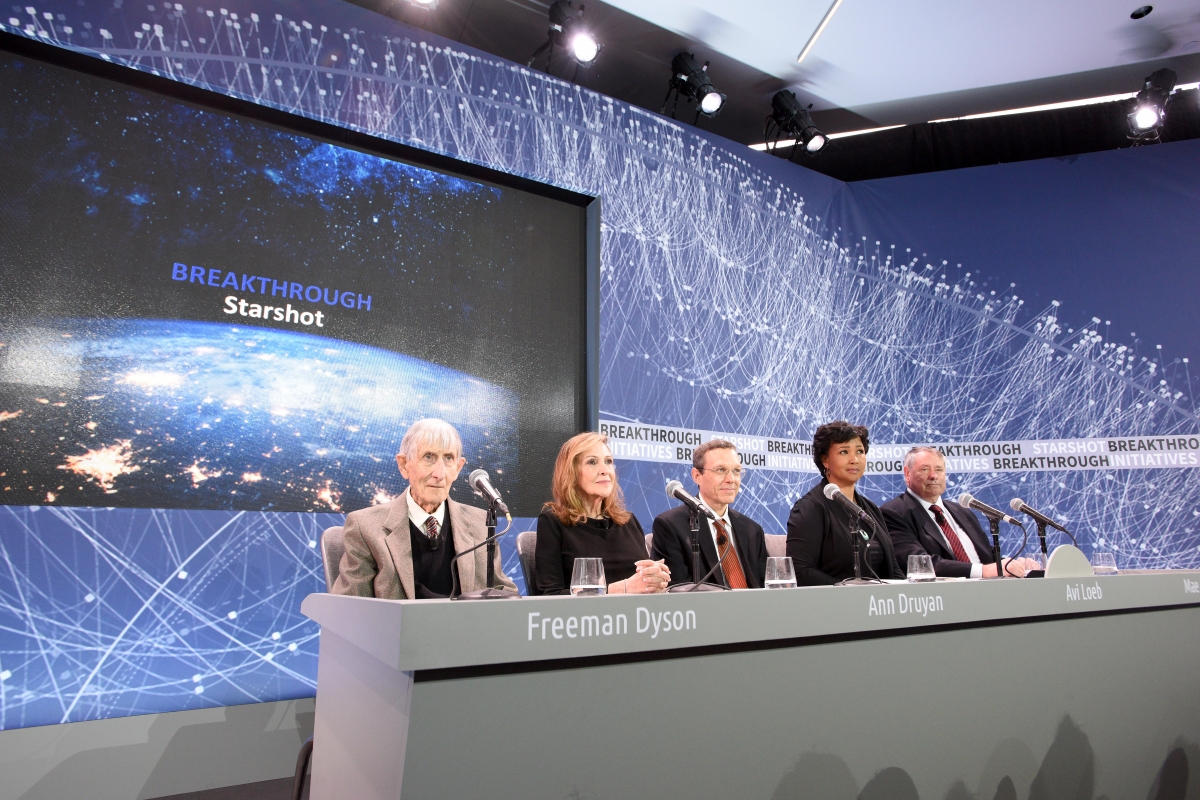
Stephen Hawking and Yuri Milner at the Breakthrough Starshot announcement
Getty Images
Professor Stephen Hawking and tycoon Yuri Milner have
revealed plans to develop a method of space travel that will go 100
million miles per hour – with the potential of reaching the stars within
a generation. The Breakthrough Starshot concept, announced at the One
World Observatory in New York, will use light beams to propel
'nanocrafts' (or tiny spacecrafts) to around 20% of light speed.
If the technology is successful, it would mean reaching our
closest neighbouring star Alpha Centauri 20 years after launch.
Announcing the project, Russian entrepreneur, venture capitalist and physicist, Milner said: "Can we reach the stars? Can we literally reach the stars? Can we do it in our lifetimes?
"The problem is space travel as we know it is slow. If
voyager left our planet when humans first left Africa, it would be
arriving at Alpha Centauri just now. How do we go faster and further?
How do we make next leap?"
He said we now have three existing technologies that can be combined
to produce high speed space travel - microfabrication, nanotechnology
and photonics. "Early proposals focused on sails driven by sun. Our own
star, as big as it is, cannot produce the force required. For
interstellar on human timescales, stronger wind on smaller boat," Milner
said.Alpha Centauri is four light years away, or 25 trillion miles. Using today's technology, it would take 30,000 years to reach it. Should the technology being proposed in Breakthrough Starshot prove successful, we could get there within 20 years.

The Breakthrough Starshot panel, including Freeman Dyson
Getty Images
Hawking
said: "What makes humans unique? I believe what makes us unique is
transcending our limits. Gravity pins us to the ground, but I just flew
to America. I lost my voice but I can speak thanks to my voice
synthesiser. How do we transcend these limits? With our minds and
machines."
"The limit that confronts us now is the great void between
us and the stars. But now we can transcend it. With light beams, light
sails and the lightest spacecraft ever built we can send to Alpha
Centauri within a generation. Today we commit to this next great leap
into the cosmos. Because we are human and our nature is to fly."
The Breakthrough Starshot initiative will see £100m invested
into developing this technology. The programme is being led by Pete
Worden, the former director of Nasa AMES Research Centre. It is being
backed by scientists and engineers, with a board consisting of Milner,
Hawking and Facebook founder Mark Zuckerberg. They plan to work out if a
nanocraft travelling on a sail pushed by a light beam can go 1,000
times faster than anything we have produced so far.
Douglas Vakoch, president of METI International, told IBTimes UK:
"By sending hundreds or thousands of space probes the size of postage
stamps, Breakthrough Starshot gets around the hazards of spaceflight
that could easily end a mission relying on a single spacecraft. Only one
nanocraft needs to make its way to Alpha Centauri and send back a
signal for the mission to be successful. When that happens, Starshot
will make history."
He said Starshot will expand our understanding of life in
space by sending humans there through their proxies (these nanocrafts).
"In 1610, Kepler proposed sending ships with sails into space, but he
never imagined sails the size of postage stamps. The key to Starshot's
propulsion system is to leave the fuel behind," he explained.
"Early proposals for
light-powered space travel suggested solar sails, driven by our Sun's
energy. But as we target other stars, as we get far from our solar
system, the Sun's light becomes too dim for a successful boost. As an
alternative, Starshot relies on an array of many small lasers, combined
into a single beam, to drive these light sails across interstellar
space. A ground-based array of lasers propels Starshot into space."
He said that Freeman Dyson's Project Orion (using fusion
propulsion) would have gotten us to Alpha Centauri in about 50 years.
"But interstellar travel relying on fusion remains a fantasy today. We
need to look to new technological advances for a realistic path to the
stars," he said.
"Fittingly for one of the Breakthrough Initiatives, Starshot
relies on the latest breakthroughs in technology. Miniaturisation
provides the foundation for Starshot's nanocraft. Redundancy is the key
to Starshot's success. Hundreds or thousands of nanocraft will be
launched. Only one needs to arrive and send back data for the mission to
be a success."
The research and engineering phase will last for a number of
years, and a huge financial investment will be required to get the
project to a stage where a mission to Alpha Centauri would be possible.
"Earth is a wonderful place, but it might not last forever",
Hawking said, "Sooner or later, we must look to the stars. Breakthrough
Starshot is a very exciting first step on that journey."

Post a Comment